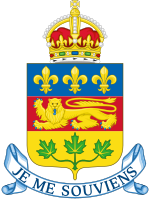
Louis-Joseph de Montcalm-Gozon, Marquis de Montcalm de Saint-Veran was a French soldier best known as the commander of the forces in North America during the Seven Years' War.

Louis de Buade, Comte de Frontenac et de Palluau was a French soldier, courtier, and Governor General of New France in North America from 1672 to 1682, and again from 1689 to his death in 1698. He established a number of Forts on the Great Lakes and engaged in a series of battles against the English and the Iroquois.

Alexandre de Prouville de Tracy was a French military leader, statesman, and the seigneur of Tracy-le-Val and Tracy-le-Mont in Picardy, France. A professional soldier, he was a regimental commander during the Thirty Years Wars, and was later appointed commissary general of French forces in Germany. In 1663, he was commissioned lieutenant-général of the French colonies in the Americas. In 1664, he led an expedition that expelled the Dutch from Guiana. The following year he sailed to New France where, in 1666, he led the Carignan-Salieres Regiment and Canadien volunteers in an invasion of the Mohawk homeland. He returned to France after reaching peace settlements with the Mohawk and the other Iroquois nations, and was appointed commandant at Dunkirk, and later governor of the Château Trompette in Bordeaux.

Events from the 1660s in Canada.

Joseph-Antoine le Fèbvre, sieur de La Barre was a French lawyer and administrator best known for his disastrous three years as governor of the colony of New France (Quebec).

Jacques-René de Brisay, Marquis de Denonville was the Governor General of New France from 1685 to 1689 and was an important figure during the intermittent conflict between New France and the Iroquois known as the Beaver Wars.
Alexandre Berthier (1638–1708) was a captain in the Allier Regiment of the French Royal Army and later a seigneur in New France. Born into a Huguenot family, he was named Issac at birth but adopted the name Alexandre after converting to Roman Catholicism in 1665. He served under Alexandre de Prouville de Tracy during the capture of Cayenne in May 1664, deployed with Tracy to New France in 1665, and was part of a major expedition against the Mohawk in the fall of 1666.
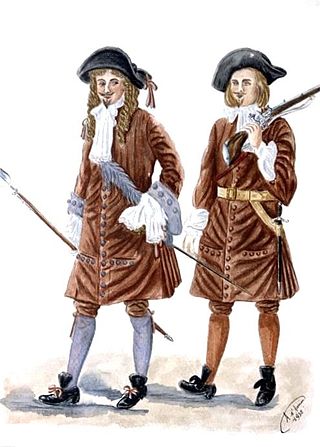
The Carignan-Salières Regiment was a 17th-century French military unit formed by the merging of two other regiments in 1659. Approximately 1,100 men from the regiment were sent to New France in 1665 to deal with the threat of the Iroquois to the colony. While in New France they were under the command of the Lieutenant Général of the Americas, Alexandre de Prouville de Tracy; the Governor General, Daniel de Rémy de Courcelle; and their colonel, Henri de Chastelard de Salières. The regiment constructed fortifications along the Richelieu River, and took part in three expeditions against the Iroquois in 1666. A peace settlement was reached the following year. Roughly 400 officers and soldiers remained behind in New France as settlers when the regiment returned to France in 1668.
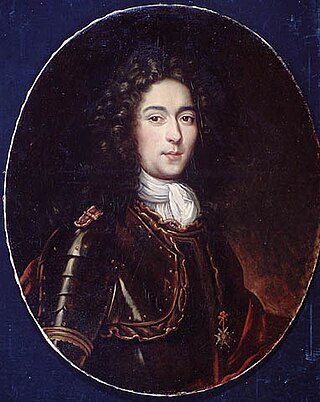
Daniel de Rémy de Courcelle, Sieur de Montigny, de La Fresnaye et de Courcelle was the Governor General of New France from 1665 to 1672.

The history of Quebec City extends back thousands of years, with its first inhabitants being the First Nations peoples of the region. The arrival of French explorers in the 16th century eventually led to the establishment of Quebec City, in present-day Quebec, Canada. The city is one of the oldest European settlements in North America, with the establishment of a permanent trading post in 1608. It was officially incorporated as a city in 1832 and given its charter in 1840.
Pierre de St. Paul, Sieur de La Motte was captain of a company of the Carignan-Salieres Regiment that was dispatched to New France (Canada) in 1665 by King Louis XIV to protect French colonists to protect French settlers aided by Algonquians against Iroquois attacks.
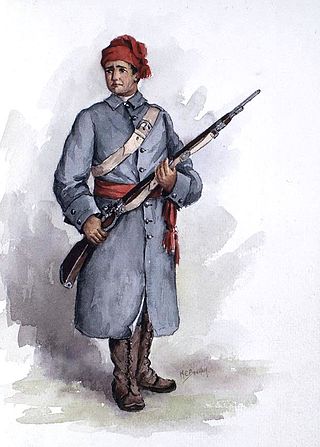
The military of New France consisted of a mix of regular forces from the French Royal Army and French Navy supported by small local volunteer militia units. Most early troops were sent from France, but localization after the growth of the colony meant that, by the 1690s, many were volunteers from the settlers of New France, and by the 1750s most troops were descendants of the original French inhabitants. Additionally, many of the early troops and officers who were born in France remained in the colony after their service ended, contributing to generational service and a military elite. The French built a series of forts from Newfoundland to Louisiana during the 1600s to the late 1700s. Some were a mix of military posts and trading forts.
Jean Bochart de Champigny, Sieur de Noroy et de Verneuil, was Intendant of New France from 1686 to 1702. His mandate was one of the longest, rivalling those of Hocquart and Bégon. He served as intendant during the terms of Governors Denonville, Frontenac, and Callière, and was in office at the time of King William's War, the Lachine Massacre, the Battle of Quebec, and the Great Peace of Montreal.

Fort Saint-Jean is a fort in the Canadian province of Quebec located on the Richelieu River. The fort was first built in 1666 by soldiers of the Carignan-Salières Regiment of France who had travelled to New France to assist the young colony. It was part of a series of forts built along the Richelieu River. Over the years, it was destroyed and rebuilt several times, but it is, after Quebec City, the military site that has been occupied non-stop for the longest time in Canada. The fort is designated as a National Historic Site of Canada, and it currently houses the Royal Military College Saint-Jean. The fort has been continually occupied since 1748, and is the core from which the city of Saint-Jean-sur-Richelieu, Quebec grew around. Fort Saint-Jean played a crucial role in the British defence strategy during the 1775 American invasion of the Province of Quebec.
Pierre de Joybert de Soulanges et de Marson was the administrator of Acadia in 1677–1678.
Pierre de Saurel (1626–1682) was a captain in France's Carignan-Salières Regiment and later a seigneur in New France. He was with the Carignan-Salières in 1665 when it was sent to New France to protect the colony from the Iroquois. When the regiment returned to France in 1668, Saurel remained behind and was granted a seigneury at the mouth of the Richelieu River, now the site of the city of Sorel-Tracy in Quebec, Canada.
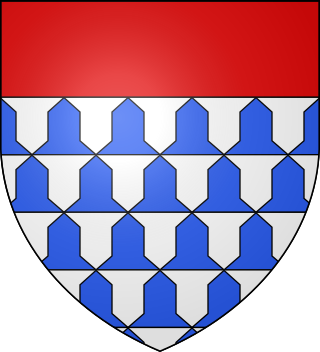
François-Saturnin Lascaris d'Urfé, S.S. was a French nobleman and Sulpician priest who became the first resident pastor of the parish of Saint-Louis-du-Haut-de-l'Île on the Island of Montreal in New France.
Gaspard-Joseph Chaussegros de Léry, was Louis XV's Chief Engineer of New France. He is recognised as the father of the first truly Canadian architecture. In 2006, the Historic Sites and Monuments Board of Canada designated him a person of national historic importance. It highlighted his contribution to the development of New France through the quality, variety, importance and scope of his work in the fields of military engineering, civil and religious architecture, and urban planning.
Thomas de Lanouguère was a soldier, seigneur and administrator in New France. He was acting governor of Montreal in 1674. His descendants adopted the surnames Lanaudière, Tarieu de Lanaudière and Tarieu de La Pérade.
Balthazard-Annibal-Alexis Flotte de La Frédière was a soldier in New France. He served as acting governor of Montreal from 1666 to 1667. His name appears as Balthazard in some sources; in some lists of the governors of Montreal, his name appears as Balthazard ou (or) Annibal-Alexis.
